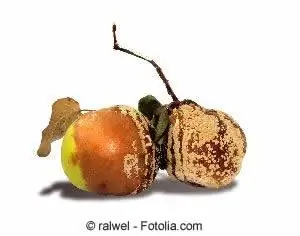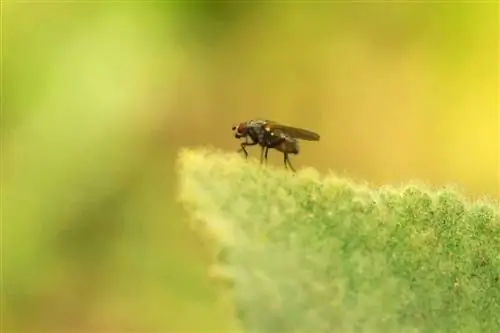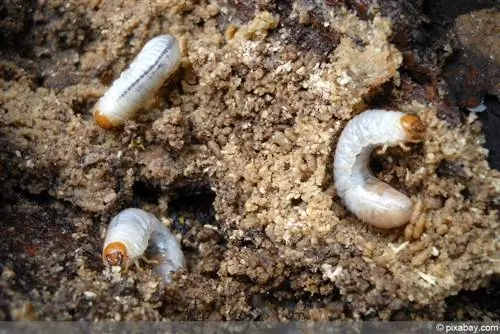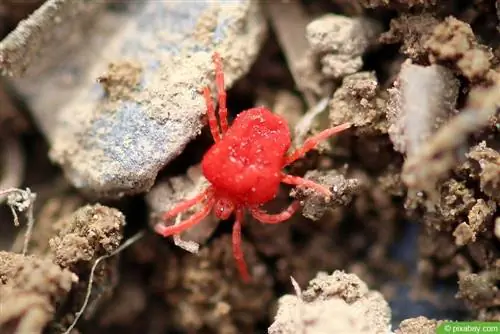- Author admin [email protected].
- Public 2023-12-17 03:39.
- Last modified 2025-01-24 12:45.
In the fight against one of the most important fruit pests, hobby gardeners are well equipped thanks to a we alth of effective control methods. When the codling moths fly off under the cover of dusk to lay their brood on leaves and fruit, they are already expected in the prepared orchard. To prevent the dreaded fruit maggots from developing in the first place, you can effectively counteract them in advance. Troubled gardeners are not powerless even against crawling larvae. Find out here how glue rings, syringes etc. take the fear out of the codling moth.
glue ring
After the codling moth larvae have wreaked havoc, they start looking for winter quarters in the bark of fruit trees in late summer. The glue ring's job is to prevent as many fruit maggots as possible from overwintering and subsequently pupating. These are 10 centimeter wide strips of paper or plastic coated with a non-toxic, non-drying adhesive. How to use the control agent correctly:
- In September, wrap the tree trunk with the rings overlapping
- Fill any resulting cavities with paper or wood wool
- Include support posts in the treatment
- Finally, coat the tracks with caterpillar glue
- Immediately remove any leaves that are stuck during the winter as a possible hiking bridge
The glue rings should be removed by spring at the latest so that no beneficial insects fall victim to them. In summer, the sticky traps lose their effectiveness because the adult moths simply fly over a ring of glue to lay their eggs.
Catch belt
Since the tubes in corrugated cardboard are extremely attractive to codling moth caterpillars, clever gardeners developed a trapping belt out of them. Since this construction cannot harm the beneficial insects in the garden, its use begins at the end of June, parallel to the main fruit maggot season. This is how the plan works:
- Wrap the trunk of a fruit tree with strips of corrugated cardboard at a height of 100 cm
- Fix in the upper area with binding wire so that the lower part sticks out like a hoop skirt
- Cover with plastic or tar paper to protect against weather influences
In the belief that they can pupate safely, the caterpillars crawl into the corrugated cardboard and can be collected. Remove the safety belts by the end of October/beginning of November to dispose of them with household waste.
Sprays
With high codling moth infestation pressure, you can no longer avoid using insecticides to save this year's fruit harvest. The following preparations are permitted for use in home and allotment gardens and achieve good results:
Granupom apple maggot-free
The biological spray acts as a feeding poison and has a selective effect on the codling moth larvae. A two-time application in May and the beginning/mid of August is usually sufficient. The two generations slip into these events so that their shameful activities are immediately put to a stop. In a garden syringe, 1.5 ml of the preparation is mixed with 5 liters of water. The addition of 5 g of sugar per liter improves the effect.
5 ml Granupoma costs around 13 euros and is enough for 16 liters of spray solution
Madex Max
This biological preparation works on the basis of granulos viruses and can be ingested by the maggots through feeding. Therefore, the spray is applied to the affected fruit trees at the same time as they hatch. Since sunlight prevents the virus from spreading, application in the evening hours proves to be beneficial. In a dosage of 1 ml per 5 liters of water, the effect is increased by adding 5 g of skimmed milk powder per liter.
30 ml Madex Max costs around 22 euros
Nemapom
The biological agent reduces the appearance of the next generation of codling moths after the fruit harvest. Beneficial insects are used that destroy up to 90 percent of the larvae living on a fruit tree. Applied as a spray or by brushing from the end of September, the tiny nematodes go on the hunt.
10 ml Nemapom costs around 16 euros and is enough for 3 fruit trees or 20 espalier plants
Wormwood Manure
The ecologically oriented hobby gardener has known it for a long time: many herbs can be found in the herb garden to combat pests. Wormwood manure has made a name for itself to combat codling moths. 300 grams of fresh, crushed wormwood leaves are mixed into 10 liters of water. During the fermentation period of 14 days, it should be stirred at least once a day. From May onwards, spray the sieved manure onto endangered fruit trees so that the bitter and tannins it contains counteract the fruit maggots.
Ingredients from your own garden for free
tansy broth
Known as a traditional remedy, tansy is also extremely effective against codling moth larvae. When applied regularly to the bark and leaves, the fruit tree is sustainably strengthened and develops natural resistance to pests. The broth is prepared by boiling 5 grams of dried tansy in 1 liter of water for 15 minutes. After it has cooled, strain it and the natural control agent is ready. If tansy does not thrive in your own garden, specialist retailers will have the plant available for purchase in dried form.
200 grams of dried tansy costs around 10 euros
Complementary control agents
In biological pest control, it is usually sensible combinations of divergent methods that achieve maximum success. As an additive to the glue ring and spray, the following precautions against codling moth are recommended:
Neudomon Apple Maggot Trap
Designed as a biotechnical pheromone trap, the males are attracted and captured here. Since only fertilized females lay eggs, this trap reduces the infestation pressure. At the same time, the design serves to monitor the flight of butterflies in order to draw conclusions for the optimal scheduling of spray agents. From May onwards, hang the apple maggot trap in the direction of the wind in the fruit tree and replace the pheromone capsule inside it every 6 weeks.
1 complete set for 1 year costs around 16 euros
Parasitic wasps
The parasitic wasp Trichogramma cacoeciae specifically targets the eggs of the codling moth. By parasitizing the eggs, the beneficial insect effectively curbs the emergence of fruit maggots. Although the insects are barely noticeable to the naked eye, they still have an operating radius of half a meter. Parasitic wasps are easily released using small cards, each with 2 on them.000 copies. When hung in the fruit tree, these cards should be replaced every 3 weeks for seamless use.
4 times 5 cards cost 26, 50 euros
Earwig
The codling moth's most important predators include earwigs, popularly known as earwigs. For these beetles, larvae are at the top of the menu. In a natural garden, it is therefore in the gardener's interest to attract these beneficial insects. Earwigs prefer to hunt for the larvae at dusk in places where there is an easily accessible place for them to retreat. Old flower pots filled with wood wool, turned upside down or hung up, are often sought out for this purpose and spent the day in. Free-standing hedges, abandoned piles of wood or leaves and hollow tree trunks also exert an irresistible attraction on the helpful beetles.
Conclusion
Thanks to a wide range of control methods, hobby gardeners are no longer powerless against the codling moth. From September onwards, glue rings and corrugated cardboard trapping belts reduce the next year's population. To combat an acute infestation, troubled gardeners can choose from various sprays, all of which are environmentally friendly. It is not absolutely necessary to purchase one, as effective insecticides can be made using wormwood or tansy from your own garden. If you combine these methods with pheromone traps and beneficial insects, you have the best chance of enjoying clean fruit, without any maggots.






